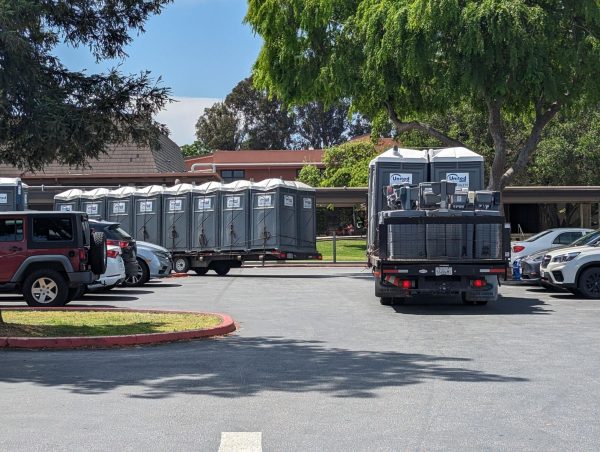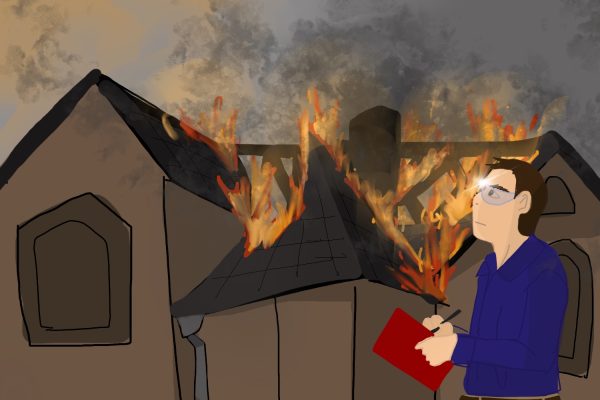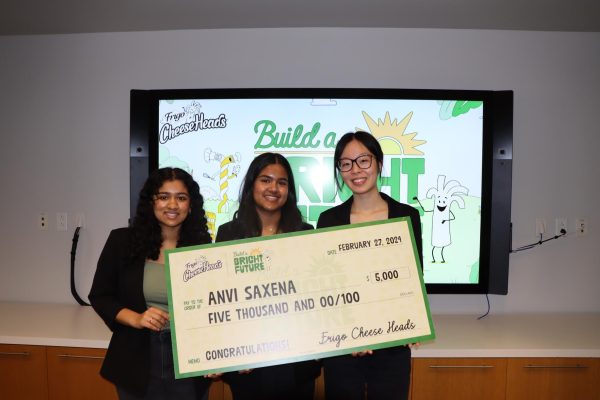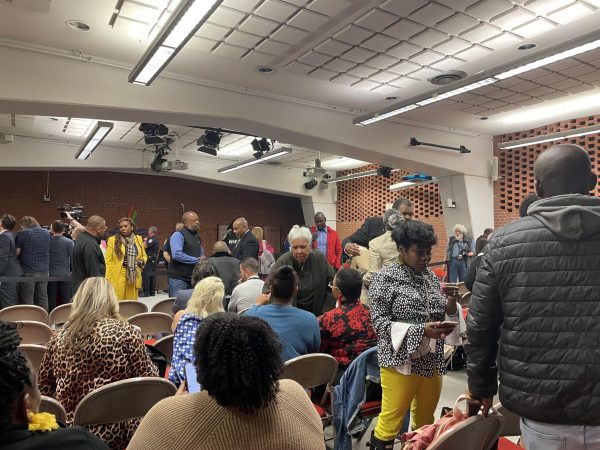Miscommunication about district move to hybrid causes concerns and confusion among shareholders
This illustration was created from a screenshot of the Board meeting in question while District Communications Director Michelle Karpinski read public comments.
October 14, 2020
At 6:30 on the evening of September 28th, community members all across Portage cleared their tabs and readied their screens for the standard bi-monthly Board of Education meeting. The meeting’s first hour passed as might have been expected, with routine updates coming to a close with no objections. The tone changed abruptly during the public comments section of the meeting, when thirty-two letters from teachers, parents, students and community members made it clear that this meeting would be anything but normal.
“I’m sorta frustrated with teachers and administration for this rumor wasting an hour and a half of our time and the administration not able to quell this rumor before it got this far,” concluded Board trustee Kurt Droppers after district Communications Director Michelle Karpinski finished reading the comments.
Droppers wasn’t alone in his opinion of the alleged “rumors.” Board trustee Robert Snyder indicated in his closing statements that, “A rumor gets halfway around the world while the truth is still getting pants on.”
This perspective extended even to board leadership, with Board vice president Terri Novaria stating at the close of the meeting, “There is so much time wasted on anxiety for something that isn’t even written down anywhere. I’m not sure where people got their ideas about what was happening and who was leading the charge.”
What the Board didn’t know was that not only was the plan written down, it had already been shared to building principals and teachers. That district administrators were planning to move from virtual to hybrid instruction wasn’t a rumor that spread within the community. It was an established fact.
First informed
Six days prior to the School Board meeting, On September 22, PPS teachers and principals were informed, in a series of meetings with district administrators, of the hybrid plan that was to be implemented on November 2, the start of the second quarter. This upset many teachers to the point of submitting their own letters in response to the hybrid model.
“I was disheartened, sad, frustrated and scared. I was under the impression we would not be changing modes of instruction until we were in Phase 5, ” said history teacher Kim Palmer.
Many teachers were concerned about how to logistically and safely make the plan work. “We were given the plan and told to start figuring out how to take what we’ve been doing to make it work. Unfortunately, it’s not that simple in that short period of time, especially with no data to indicate the need to move to hybrid so quickly,” Palmer elaborated.
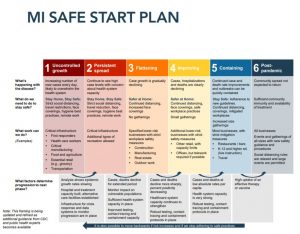
North Middle English teacher Johanna Toth was similarly concerned. “I was very surprised to hear that the district changed from the original plan to now include face to face in secondary schools despite the fact that Michigan is still in phase 4,” she said. “I also began looking for ways to accommodate this big, unexpected change.”
These concerns led many teachers, including Palmer and Toth, to write letters to the school board with their concerns. “I began asking questions about the change planned by the district, but I was unable to access answers to my questions. So, I reached out to the board for clarification on the issues in question,” said Toth.
Students also found out about the news and wrote in to the school board. Senior Rachel Budnick, who penned a comment opposing the impending return to school, felt moved to respond after learning about the proposed shift to hybrid learning in one of her classes. “I was not aware of the teacher meetings,” she said. “This was the first time that I had heard of it. It took me by surprise because the idea seemed to have come up so abruptly.”
Budnick, Palmer, Toth, and 29 others emailed the school board with their questions and concerns about the plan. At this point, however, the school board had not yet been informed of the plan to implement a hybrid model for quarter 2.
Concerns
Returning to the night of September 28th, after the meeting began, Assistant Superintendent Michael Pascoe presented a routine COVID-19 update. “The Covid-19 global pandemic has impacted our school community in a number of ways,” he explained. “For many, it’s a traumatic event in which some students have significant gaps in their learning and we’re seeing equity issues that are more pronounced than ever before.”
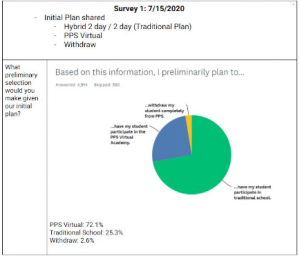
Pascoe elaborated on the divide interpreted to increase disparity in equity: “We have families that have advocated from day one that all of our students be back in person in classrooms with their teachers, at the same time, we have families that want to stay virtual for the remainder of the school year until a Covid-19 vaccine has proven effective,” he said, indicating that district administration was in a predicament: they sought equity for students while negotiating contrasting perspectives from families.
An important factor to consider is that equity doesn’t just apply to the students receiving the education, but also the educators tasked to teach in new environments. Spanish teacher Kaitie Paynich shared her conflicted perspective in her letter to the Board: “As I see it right now, the only way for me to provide any semblance of equitable instruction is for me to stay seated at my desk and deliver instructions from there,” she said. “So that I can field questions from all students, both in person and via chat.”
Beyond sharing her frustrations with the proposed plan, Paynich posed the question, “Why bother at all with in person instruction if the best mode is for me to treat it as though everyone were still at home?” Her inquiry stems from the reality that transitioning to the hybrid model proposed by the district would require teachers to teach in-person and at-home learners simultaneously, keeping both groups at the same pace in class with one group never getting ahead of / having advantages over the other.
Paynich isn’t alone in her difficulty with an equitable hybrid model. English teacher and forensics director Cece Weeks shared in her letter, “This will not be equitable, my attention will be split, my focus will most likely go to the students in the room.” While attempting to reach admin’s goal of equity, teachers find themselves pulled in both directions under the proposed hybrid model.
The district’s handling of COVID-19 doesn’t just impact Weeks’ as an educator, but as a parent as well. “I made the very difficult decision to withdraw my own elementary age students from PPS and send them to private school because the plan for elementary was very poorly communicated and very unsafe,” said Weeks. “We withdrew our children in person and followed up with an email to the elementary principal,” she recalled. “Just today I received a phone call asking if my children were going to continue face to face for next semester. Clearly my children are still in the system, so why haven’t they contacted me to ask where my kids are and where they’ve been?” This is another of many examples of the communication issues that have plagued the district throughout the pandemic.
The 2020-2021 school year has already crafted many firsts within the district. After teaching with PPS for twenty-seven years, Palmer shared in her letter, “This year has been the most challenging of my career. . . I’m working harder than ever and was filled with panic this summer with last minute plans and few answers.” Despite the arduous start, Palmer indicated to the Board that she and her students were hitting their stride virtually: “I’m discovering I can teach online,” she said. “My students and I are becoming a great team.”
The reality of the current situation is not lost on Palmer, who is well-known as an advocate for students. “While we know an in person education is best, I’d rather not risk my life and theirs on empty promises of cleanliness and social distancing,” she stated.
Palmer closed her letter with three requests. “Please don’t ask your teachers to plan for another completely new mode of instruction that we know as professionals not best practice. Please do not ask us to do this and not be effective for our students. Please don’t ask us to do this with no answers or proper planning. We should not be asked to figure this out as we go when we are just starting to figure out online.”
Like Palmer, coach, physical education teacher, and Portage Education Association President Chris Furlong advocates for teachers and students alike. Detailing his frustrations with the sudden move to hybrid, Furlong asked, “What has changed? We are still in phase four, the cases have not gone down enough to get to phase five. And [the school board] voted to stay in virtual until phase four is over and thus is it safer for us to return.”
Confronted with a hybrid model aimed to begin as soon as the second quarter, Furlong recalled, “The plan at this point without clear guidance is to bring kids back to school and let them be in our rooms while staring at a computer screen all day,” he further expressed. “This is not face to face. This is babysitting.”
Opposition towards the hybrid model wasn’t just felt by educators, but their pupils. Submitting a comment of her own, junior Grace Freed shared her discontent with a question. “Dear school board members, do you have kids? You, the person reading this, do you have kids? I’m a kid, a junior at Northern and I can tell you right now, switching to a hybrid plan for the second marking period is a terrible idea.”
Faced with the conflict of continuing virtual learning or to reintegrate face to face, Freed details the difficulty behind her decision. “I have the ability to stay home and will continue to learn virtually, which I would do due to the lack of safety I already know will not be there,” she further explained. “[Yet] if I stay virtual, while even just some of my peers go back, my quality of education will suffer.”
Despite emerging confident with her decision to stay virtual, she feels the administration isn’t prioritizing safety. “It seems as though the administration only cares about getting people back to school as fast as possible and not about the safety of kids or teachers,” says Freed.
Standing alongside her fellow student, Budnick believes important factors aren’t being evaluated. “While considering back to school options I think it is important to consider and weigh all of the options. Personally I’ve had to quarantine more than once since school has started,” Budnick shared in her letter. “The majority of students want to go back to school for the second quarter, but I believe that the earliest we should go back to in-person learning is the beginning of the second semester.”
Although Budnick’s school year isn’t what she hoped for, she doesn’t forget what comes first. “I am someone who loves personal and social interactions. I’m also a senior who’s devastated that I cannot have the senior year that I always dreamed of,” said Budnick.
“I miss my teachers, my classmates and my friends, but when it comes to the safety of students and staff and their families, these social interactions can wait. Safety should always come first, and right now it is better to be safe than sorry.”
Aftermath
School board members found themselves inundated with a flurry of community concern over an issue that they had yet to be briefed about, resulting in some members issuing parting statements that could be perceived as placing the blame on teachers, parents, and students for getting worked up over nothing. “Up until 5 minutes after the meeting, the Board was under the impression the district was in discussion mode. We could not understand why there was so much anxiety over discussions. The reason for the anxiety became obvious after the meeting concluded,” Board trustee Rusty Rathburn recalled. “That was when staff members presented us administrative memos which clearly indicated that the district would utilize Hybrid Learning Model effectively at the end of the marking period.”
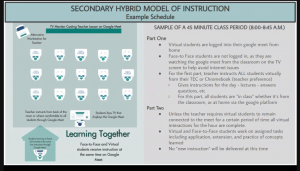
Many school board members clarified their thoughts and feelings after learning more about the situation. Droppers described the difficulty and miscommunication of his initial statement. “From the meeting, I went on record stating that I was disappointed that the process got as far as it did with teachers submitting letters (over 30 of them) of concern and administration basically staying silent,” he explained. “I didn’t understand the whole situation and I didn’t know that there had been correspondence regarding the subject in question.” When reflecting on his response later, he added, “I was frustrated that the administration let it go that far, and I was frustrated with the teachers and the letters because I didn’t understand why the teachers were so frustrated. Now, I know. The whole situation is just too bad.”
Snyder indicates this miscommunication could have been avoided. He expressed disappointment that the admin didn’t interject, even at the last moment. “My initial reaction was that they must have heard a rumor or some type of misinformation because no such proposal was on our agenda. Further, the superintendent, who was present at the meeting, did not interject to clarify,” Snyder explained.
Since learning the correct information, for the original hybrid plan, Snyder has had a change of perspective. “Following the meeting, my email box filled up with teachers forwarding documents indicating that planning was, indeed, underway for implementing a hybrid model that would start with the 2nd marking period,” Snyder clarified. “I am very disappointed that the board had not been made aware of those plans.”
Beyond his disappointments, he knows one thing for certain. “I want to thank teachers who brought us accurate information in good faith that evening. My heartfelt apologies to them. Teachers also have my thanks for following up with further information that brought more clarity. I appreciate and respect their tenacity,” explained Snyder.
Novaria feels their initial responses at the close of the meeting were distorted. “I believe what I and other board members may have said was misinterpreted,” she said, expressing disappointment on all fronts: “We were not only shocked, but felt we had been duped on all sides. We had not received the appropriate information from anyone prior to the meeting. Not administrators, not teachers.” Like Snyder, Novaria iterated that this didn’t need to happen and could have been resolved with communication. “If I and other board members had been able to validate the information from the beginning, a lot of angst could have been avoided. This should never have happened,” she said.
Rathburn echoed his colleagues’ dismay “I am disappointed,” he said. “I am disappointed the administration never shared with us that this was the plan, not a rumor. I was disappointed that the administration gave us an extremely vague presentation, once again leading us to believe these were discussions.” He also expressed concern that the Board was not notified ahead of time by the Portage Education Association, which is the union that represents Portage teachers. “I can’t grasp why nobody from union leadership gave that information until after the meeting,” he said.
As the only serving board member with children currently attending Portage schools, Rathburn has a unique perspective. “I’m 100% satisfied with Gabe and Luke’s online learning,” he shared. “The teachers are doing an amazing job engaging and teaching kids.”
He is also aware and acknowledges it’s not for every student. “I think we are losing the battle with many kids. Online learning requires a lot of variables to be successful. Beyond the excellent teaching, kids must have self-learning skills,” said Rathburn. “Some kids require direct supervision. Not all kids have engaged parents assuring school work is getting done. And most kids need the social emotional aspect in-building instruction provides. My senior, Gabe, misses that immensely.”
Despite having already known of the proposed hybrid plan, teachers felt sidelined and excluded from discussion after the meeting. Toth is candid as she recalls feeling defeated while searching for hope. “Honestly, I hung up from the board meeting feeling a little defeated. I was looking for answers on how to keep my community safe, and some of the board seemed upset about that. I felt slapped on the wrist for asking questions,” she shared.
Furlong expressed his disappointment on behalf of himself and PEA member teachers. “We have a highly effective superintendent, and yet he has no understanding for the struggles that teachers face every day in this environment,” he said. “Nor has he assembled a team that can come up with a clear plan for how this will work. We have a curriculum team that listens to a selected population for guidance, not looking for a more diverse set of examples.” Furlong does, however, see a way forward: “They should be focusing their efforts on seeking out many schools and individuals for guidance,” he said. “I would ask that our curriculum team explore more options and diverse populations to guide their decisions and practices.”
Apology
“In my personal efforts to be a good leader, and a good person for that matter, I believe it is important to recognize and acknowledge when I have made a mistake,” Superintendent Mark Bielang began to explain in an emailed blog post to the Portage Public Schools school board and staff.
“As a District, we are required to submit an Extended Continuity of Learning Plan (ECLP) to KRESA by October 1, 2020,” he continued. “It is not required that local boards approve the plan prior to submission even though local boards must reconfirm the plan every 30 days. . .We scheduled a presentation of the ECLP to the board at the September 28, 2020 meeting as an information item so that board members were aware of the elements of the plan and what was being submitted,” Bielang shared. September 28 was two days before the plan had to be filed, leaving little time to alter it.
Bielang’s assertion that the district does not require approval from the school board appears to be in conflict with the Portage Public Schools handbook, as the hybrid learning plan presented to the Board represented a change from the original plan, not a continuation of it (the original plan stipulated that virtual learning would occur as long as Portage’s region of the state was in Phase 4). According to the handbook, administration must get the approval of the board before submitting the schoolwide plan that would affect the entire community.
Bielang soon admitted he was wrong in his assumptions of not having to get the board’s approval. “Any changes to that plan (for example, moving toward a hybrid delivery model while in Phase IV) required Board approval,” he said in his blog post. “Up until Monday morning, we had been moving forward under the assumption that board approval was not required and that changes to instructional delivery could be made through the ECLP.”
The apologetic post also takes the blame for the lack of communication the district displayed. It also outlines a rationale behind the proposed change: “We are seeing more and more evidence that so many students are not engaged and/or thriving under the virtual only plan,” it read. It also indicated that the district would slow plans to return to face to face learning: “We heard you,” the post concludes. “So, as Dr. Pascoe and Mr. Huber told you yesterday, we are holding off on the November 2nd timeline for implementation of the hybrid model. We all know kids need to be back in school, and we recognize that we need to take the time needed to make sure that we can do it responsibly. . .We know we don’t always get it right, but what I do know is that we all want to be transparent and accountable as we work together to achieve our mission and approach our vision.”
Huber and Pascoe both issued their own apologies to teachers and teacher leaders in communications that were internal-only at the time this article was published.
Moving forward
In an effort to move toward better communication between district administration and PPS families, Superintendent Bielang sent out an email to the school community outlining changes to move forward.
“We want to let you know that we are taking steps to listen more prior to the implementation of any 6-12 hybrid model of instruction,” it states. “We still have work to do to answer the key questions about instructional delivery, cleaning, lunch, class changes, etc.”.
The email goes on to further explain a survey sent out on Sept. 25 in which families will be able to state their preference of a hybrid or virtual model. Bielang states that there are strong opinions on all sides when it comes to returning to school and highlights that administration “is working to make decisions that are best for students. . .We also recognize there is not a one size fits all solution. Any changes in the way we deliver your student’s instruction while we are in Phase 4 will be presented to the School Board for approval.”
Next steps
Legendary football coach Bear Bryant once said, “when you make a mistake, there are only three things you should ever do about it: admit it, learn from it, and don’t repeat it.” The communication mistakes surrounding the hybrid return to learn plan sparked multi-level miscommunication, controversy, and fear within the Portage school community, and the Board is looking forward with optimism. “We are committed to all the people we represent – students, parents, teachers, staff, and administration,” said Droppers. “We want our students to have the best educational experience that we can provide. We want our students to be back in school, but we need to make sure that this is done as safely as possible.” In this case, everyone involved seems to have admitted their mistake. Going forward, only time will tell if they learned from it and are committed to not repeating it.
Click here to stay up-to-date on the newest information regarding the PPS Return to Learn Plan.
This story was originally published on The Northern Light on October 13, 2020.



























![IN THE SPOTLIGHT: Junior Zalie Mann performs “I Love to Cry at Weddings,” an ensemble piece from the fall musical Sweet Charity, to prospective students during the Fine Arts Showcase on Wednesday, Nov. 8. The showcase is a compilation of performances and demonstrations from each fine arts strand offered at McCallum. This show is put on so that prospective students can see if they are interested in joining an academy or major.
Sweet Charity originally ran the weekends of Sept. 28 and Oct. 8, but made a comeback for the Fine Arts Showcase.
“[Being at the front in the spotlight] is my favorite part of the whole dance, so I was super happy to be on stage performing and smiling at the audience,” Mann said.
Mann performed in both the musical theatre performance and dance excerpt “Ethereal,” a contemporary piece choreographed by the new dance director Terrance Carson, in the showcase. With also being a dance ambassador, Mann got to talk about what MAC dance is, her experience and answer any questions the aspiring arts majors and their parents may have.
Caption by Maya Tackett.](https://bestofsno.com/wp-content/uploads/2024/02/53321803427_47cd17fe70_o-1-1200x800.jpg)
![SPREADING THE JOY: Sophomore Chim Becker poses with sophomores Cozbi Sims and Lou Davidson while manning a table at the Hispanic Heritage treat day during lunch of Sept 28. Becker is a part of the students of color alliance, who put together the activity to raise money for their club.
“It [the stand] was really fun because McCallum has a lot of latino kids,” Becker said. “And I think it was nice that I could share the stuff that I usually just have at home with people who have never tried it before.”
Becker recognizes the importance of celebrating Hispanic heritage at Mac.
“I think its important to celebrate,” Becker said. “Because our culture is awesome and super cool, and everybody should be able to learn about other cultures of the world.”
Caption by JoJo Barnard.](https://bestofsno.com/wp-content/uploads/2024/01/53221601352_4127a81c41_o-1200x675.jpg)





